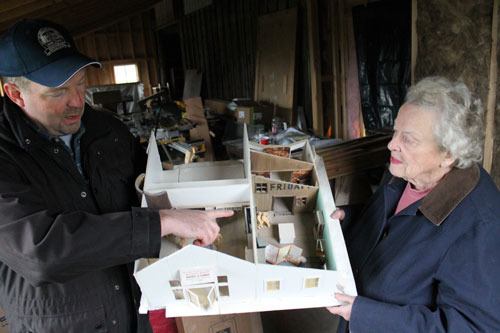It takes technology to preserve the past. That’s why the exhibit under construction at the San Juan Historical Museum will be different from anything that’s been built before.
More than an exhibit really, it’s a museum within the museum.
An indoor dock will lead you through the fishing section, where there’s an interactive fishing station, and you can learn the tricks of the trade. There will be a three dimensional window to look in and see people working at the old cannery, standing in rooms with fish up to their knees. There will be a lime kiln replica, machinery and artifacts, all this and more in a 2,700 square foot barn.
“Museums are evolving with technology, you can’t just put an old photo and a caption anymore,” said Kevin Lofftus, executive director of the San Juan Historical Museum. “We want to be in the same breath when people talk about places to go.”
Bold, intricate and creative–the Museum of History and Industry will function as a permanent exhibit, and could put the Historical Museum on the map for top things to do on San Juan.
The new exhibit will focus on the island’s major industries of the 1900s–fishing, farming, logging and lime. From the men who cut cords of wood for the lime kilns and steam ships, to the women and children who canned salmon, this new exhibit plays homage to the pioneers of modern society.
Presently Lofftus is gathering stories and snippets from the past, interviewing some of the last remaining people on the island from this time. He said it’s the stories, not the artifacts, that will drive the exhibit’s content.
“These people are getting up in years and once they’re gone, who’s going to remember?” he said. “We want this to be a place to come and see what life was like, so it’s not forgotten.”
The idea to curate an industry exhibit was born nearly a decade ago, but the project didn’t get underway until 2012. Its grand opening is not expected until 2016, but there will be soft openings along the way as sections are completed.
What started as a $200,000 budget quickly grew to $300,000 with added infrastructure, heat, and electricity. When you add up the technology, art, and design needed to execute the vision, the Museum of Industry and History will cost upwards of $500,000.
Lofty goals with a budget to match, Lofftus said the Museum won’t take out loans or accrue any debt to finish building and curating the space. Like the Historical Museum, the Museum of Industry and History is funded through memberships, grants, donations, and county lodging taxes.
So for now it’s dry wall and plaster, story and artifact gathering. Lofftus hopes that the atrium, scheduled to be completed first, will be open to those that visit the museum’s grounds by early 2015.
Although the Museum of History and Industry will be more advanced than the exhibits currently offered at the Historical Museum, the intention is the same, to look after the past.
“The generations of people who performed this work aren’t here anymore,” said Museum board president Mary Jean Cahail. “If we don’t work to preserve history it will be lost.”



